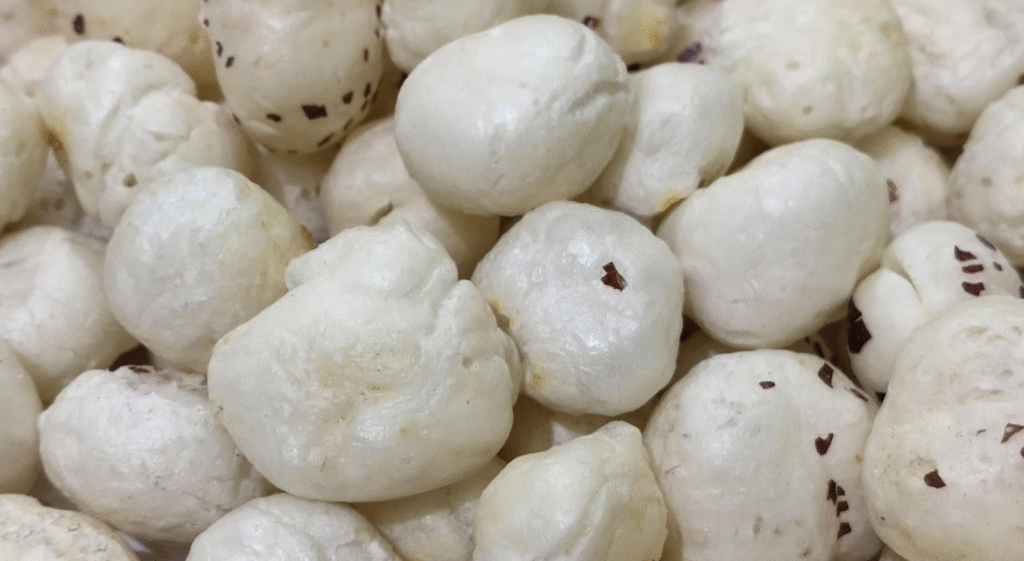Makhana, also known as fox nuts or lotus seeds, is a traditional snack that has been enjoyed in India for centuries. It comes from the seeds of the lotus flower, which are harvested, dried, and then roasted to create a light and crunchy snack. Makhana is often eaten during fasting periods, but in recent years it has also gained popularity as a healthy alternative to processed snacks like chips and biscuits.
The main reason people choose makhana is because of its nutritional value. It is low in calories, packed with plant-based protein, and a rich source of fiber. It also contains important minerals like calcium, potassium, and magnesium. Because of these nutrients, makhana is considered good for weight management, digestion, and overall health.
What makes makhana stand out is that it can be prepared in different ways. You can roast it with ghee and spices, mix it in curries, or even use it in desserts. Its versatility has made it a part of both traditional and modern diets. But with more people focusing on gluten-free eating, the big question arises—is makhana gluten free? Let’s find out.
Is Makhana Gluten Free?
Yes, makhana is naturally gluten free. Gluten is a type of protein found in wheat, barley, and rye. Since makhana is a seed that comes from the lotus plant, it does not contain any gluten. This makes it a safe choice for people who have gluten intolerance, wheat allergies, or celiac disease.
In fact, makhana is often recommended as a healthy snack for people who follow a gluten-free lifestyle. It can replace processed snacks that usually contain wheat-based ingredients. Roasted makhana, for example, is a simple and natural option that does not require any flour coating or gluten-containing additives.
However, while makhana itself is gluten free, one thing to keep in mind is how it is processed or flavored. Some packaged makhana snacks may be mixed with seasonings that contain wheat flour or other gluten ingredients. That is why people with gluten sensitivity should always check labels before buying flavored makhana from the market. Plain roasted makhana, on the other hand, is naturally safe and gluten free.
So, the answer is clear—makhana is gluten free, but always pay attention to added flavors or ingredients that may change its natural quality.
Health Benefits of Eating Makhana
Now that we know makhana is gluten free, it’s worth looking at why this snack is becoming popular worldwide. Beyond being safe for those avoiding gluten, makhana offers several health benefits:
1. Good for digestion – Makhana is rich in fiber, which helps improve digestion and prevent constipation. Since it is light on the stomach, it can be eaten at any time of the day.
2. Weight management – Being low in calories and high in protein, makhana keeps you full for longer and prevents overeating. This makes it an excellent option for people trying to lose weight.
3. Heart health – The magnesium and potassium in makhana help maintain blood pressure levels and support heart health.
4. Bone strength – With calcium as one of its key nutrients, makhana helps in strengthening bones and maintaining overall bone health.
5. Anti-aging properties – Makhana contains antioxidants that fight free radicals in the body, which helps slow down the signs of aging like wrinkles and dull skin.
6. Good for diabetics – Since makhana has a low glycemic index, it does not cause a sudden spike in blood sugar levels. This makes it a suitable snack for people with diabetes.
In short, makhana is more than just a gluten-free food—it is a powerhouse of nutrition that supports overall health.
How to Add Makhana to a Gluten-Free Diet
For those following a gluten-free lifestyle, including makhana in your diet is simple and enjoyable. Here are some easy ways to use it:
1. Roasted snack – The easiest method is to dry roast makhana with a small amount of ghee or oil and sprinkle it with salt and black pepper. This makes a crunchy, guilt-free snack.
2. Flavored makhana – For more variety, you can add spices like turmeric, red chili, or chaat masala while roasting. This gives the snack a tangy and spicy twist without using any gluten.
3. Makhana curry – Makhana can be added to curries or gravies. It absorbs flavors well and gives a creamy texture to the dish.
4. Makhana kheer – For those who love desserts, makhana can be used in traditional Indian kheer (pudding). It is cooked with milk, sugar, and dry fruits, making it a wholesome sweet dish.
5. Breakfast option – You can mix roasted makhana with nuts and seeds to create a gluten-free trail mix for a healthy breakfast or mid-morning snack.
By experimenting with these recipes, you can enjoy makhana in multiple forms without worrying about gluten. It is both tasty and safe for those with dietary restrictions.
Why Makhana is Becoming Popular Worldwide
Although makhana has been a part of Indian diets for generations, it is now gaining attention globally. The rise of gluten-free diets has played a big role in this trend. Many people are now choosing foods that are naturally gluten free, and makhana fits perfectly into this category.
Additionally, health-conscious consumers across the world are always looking for snacks that are low in calories, high in nutrition, and free from harmful additives. Makhana checks all these boxes. Its ability to be consumed in different ways—savory, sweet, or plain—makes it even more attractive to international markets.
Fitness enthusiasts and dieticians also recommend makhana as a better alternative to packaged chips and fried snacks. Its growing availability in health food stores and online platforms shows that makhana is no longer limited to Indian households but is becoming a global superfood.
FAQs on Makhana and Gluten
Q1: Is makhana always gluten free?
Yes, natural makhana is always gluten free. Only flavored or packaged versions may sometimes have gluten-containing ingredients.
Q2: Can people with celiac disease eat makhana?
Yes, plain makhana is safe for people with celiac disease. Just ensure that it is not processed with gluten-containing additives.
Q3: Is roasted makhana healthier than fried snacks?
Absolutely. Roasted makhana is light, low in calories, and much healthier compared to fried snacks like chips.
Q4: How much makhana should I eat daily?
A handful (about 30–40 grams) of roasted makhana is enough for a healthy snack portion.
Q5: Can makhana be eaten during fasting?
Yes, makhana is a popular food during fasting in India because it is light, filling, and nutritious



